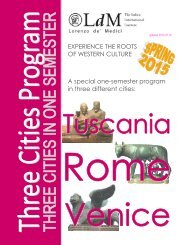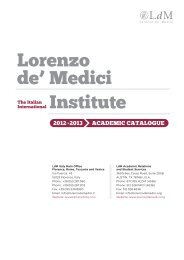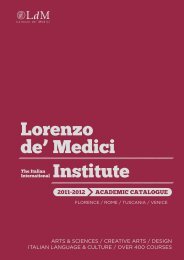aCademiC Catalog 2013-2014 - Lorenzo de Medici
aCademiC Catalog 2013-2014 - Lorenzo de Medici
aCademiC Catalog 2013-2014 - Lorenzo de Medici
Create successful ePaper yourself
Turn your PDF publications into a flip-book with our unique Google optimized e-Paper software.
FLORENCE<br />
School of Arts & Sciences<br />
The Nu<strong>de</strong> in Mo<strong>de</strong>rn Art<br />
ART 225 F<br />
Cr: 3; Contact hrs: 45<br />
Since the beginning of art history, the human body has fascinated<br />
countless generations of artists, becoming since ancient times<br />
the supreme form of artistic expression. The nu<strong>de</strong> became a<br />
genre in itself, used to represent religious and mythological<br />
figures, gods and god<strong>de</strong>sses, legendary heroes and even i<strong>de</strong>as,<br />
<strong>de</strong>spite the negative reaction that sometimes followed the<br />
unveiling of the work. But if for the more conservative the nu<strong>de</strong><br />
was scandalous and sinful, for the artist it was an expression<br />
of freedom and human beauty and sensuality, of the pureness<br />
of being. The nu<strong>de</strong> in the history of art is thus a subject both<br />
traditional and transgressive, with broad implications for our<br />
un<strong>de</strong>rstanding of art and humanity. This course explores these<br />
themes with special attention to the period from the late 18th<br />
century to the late 20th century.<br />
The World of Museums: Museology<br />
ART 230 F<br />
Cr: 3; Contact hrs: 45<br />
The aim of this course is to provi<strong>de</strong> an integrated approach to<br />
museum theory and practice in Italy. It will consi<strong>de</strong>r museum<br />
<strong>de</strong>finitions and classification, and the century-long history of<br />
art collecting, examining the various forms and meanings of<br />
gathering beautiful, precious or even curious objects in various<br />
places, including the creation of world-famous museums such<br />
as the Uffizi or the Louvre. The concept of cultural heritage will<br />
be analyzed, consi<strong>de</strong>ring its increasing value for society, as well<br />
as the legal and ethical issues involved. The course will also<br />
provi<strong>de</strong> the stu<strong>de</strong>nt with the basic knowledge of the main issues<br />
in museum curatorship: research, methods of documentation,<br />
cataloguing systems, display, basic communication techniques,<br />
the importance of education in museums, preventive and<br />
remedial conservation of collections, environmental monitoring<br />
and control, safety plans and storage systems.<br />
Mysteries and Sacred Knowledge in<br />
Architecture<br />
ART 243 F; Dual listed: PHR 243 F<br />
Cr: 3; Contact hrs: 45<br />
This course explores the architecture of various past cultures<br />
relative to their belief systems, and links this to contemporary<br />
practice. It reads buildings and spaces as the products of<br />
diverse forms of special sacred knowledge or wisdom, whose<br />
language can be reconstructed, un<strong>de</strong>rstood, and enjoyed. Key<br />
themes inclu<strong>de</strong>: esoterism; concepts of harmony, proportion<br />
and geometry; numerology; astrology and cosmology; the<br />
architect as creator; symbolism; ornament. Cultures examined<br />
inclu<strong>de</strong> ancient Egypt, classical antiquity (Greece and Rome),<br />
ancient India (vaastu), ancient and mo<strong>de</strong>rn China (feng shui),<br />
medieval, Renaissance and Enlightenment Europe. From the<br />
proportions of a pyramid to a freemason’s lodge, from the<br />
capitals of a cathedral to the planning of a resi<strong>de</strong>nce or square<br />
in ancient or Renaissance Rome, the course seeks common<br />
elements that may connect all cultures. Stu<strong>de</strong>nts discover new<br />
interpretative keys that offer profound perspectives on the art<br />
and craft of architecture, from antiquity to today.<br />
Palaces of Florence<br />
ART 245 F<br />
Cr: 3; Contact hrs: 45<br />
The aim of this course is to introduce stu<strong>de</strong>nts to the history<br />
of the palaces of Florence from 13th to 17th centuries. Public<br />
and private palaces had an important role in the life of the city<br />
through the centuries, and, by studying them, stu<strong>de</strong>nts will<br />
have the opportunity to un<strong>de</strong>rstand not only the <strong>de</strong>velopment<br />
of their architectural style, but also the social, economic,<br />
cultural, and political history of Florence, in an interdisciplinary<br />
approach to the subject. Stu<strong>de</strong>nts will study the evolution of<br />
Florentine palaces directly in front, and insi<strong>de</strong>, of the buildings:<br />
many of the lessons will be held on site, and site visits form a<br />
crucial dimension of the learning experience.<br />
Architectural History: Italian Urban Design<br />
ART 248 F; Dual listed: ARC 248 F<br />
Cr: 3; Contact hrs: 45<br />
The course embraces ancient <strong>de</strong>sign to mo<strong>de</strong>rn Italian urban<br />
landscape, analyzing the formal layout as well as the cultural and<br />
social background of Italian cities. Stu<strong>de</strong>nts will study Etruscan<br />
and pre-Roman towns, Roman imperial towns, medieval and<br />
Renaissance towns, the Baroque environment, the cities of<br />
the 19th century, new towns which were <strong>de</strong>veloped during the<br />
Fascist era, post-war reconstruction, and contemporary town<br />
planning. The aim of the course is to give stu<strong>de</strong>nts the tools to<br />
“read” the landscape of Italian towns as complex environments<br />
created during a long phase of different superimposed urban<br />
textures.<br />
Lost Symbolisms: Secret Co<strong>de</strong>s in Western<br />
Art<br />
ART 255 F; Dual listed: PHR 255 F<br />
Cr: 3; Contact hrs: 45<br />
The course focuses on the links between artworks and astrology,<br />
alchemy, geometry, numerology, and selected philosophical<br />
themes in Western art between 1300 and 1800. Art has served<br />
various functional and aesthetic purposes in different cultures<br />
and periods. In some eras art has also embodied a symbolic<br />
language, mysterious to the majority but highly significant to<br />
the minority able to read or <strong>de</strong>co<strong>de</strong> it. For example, what we<br />
may call the secret messages of certain paintings and sculptures<br />
of past centuries can be interpreted in terms of astrology.<br />
A specific field of art history, iconography, studies subject<br />
matter, symbolism, and signification in works of art. Stu<strong>de</strong>nts<br />
use elements of this approach to examine the fascinating and<br />
complex range of meanings that some artworks were inten<strong>de</strong>d<br />
to transmit and which can still be recovered.<br />
World Art<br />
ART 260 F<br />
Cr: 3; Contact hrs: 45<br />
This course explores Western and non-Western artistic<br />
traditions from ancient era to the 20th century. Major artistic<br />
trends, monuments and artworks from all over the world will<br />
be discussed stressing differences, analogies and reciprocal<br />
influences. Parallel to the study of western art, this course<br />
offers a non-Western perspective which consi<strong>de</strong>rs artworks<br />
from Egypt, the ancient Near East, China, Japan and India.<br />
The emphasis of the course is to <strong>de</strong>velop an un<strong>de</strong>rstanding<br />
and appreciation of various art forms from cultures scattered<br />
around the world which have existed for thousands of years,<br />
representing multiple distinct lines of <strong>de</strong>velopment. Artistic<br />
trends will be related to their social, political and economical<br />
context by consi<strong>de</strong>ring broad thematic areas such as religion<br />
and cultural continuity, rulership and political integration,<br />
patronage and social status. Links, differences and cultural<br />
interactions between different civilizations will be stressed to<br />
better un<strong>de</strong>rstand the concept of “cultural i<strong>de</strong>ntity” in the era<br />
of globalization.<br />
Anthropology of Art<br />
ART 265 F; Dual listed: ANT 265 F<br />
Cr: 3; Contact hrs: 45<br />
Art is a human universal, and for this reason it can be<br />
un<strong>de</strong>rstood and studied as a characteristic of our species, like<br />
other products of human evolution. At the same time, art is also<br />
a sociocultural product and a personal creation: it is a place<br />
where biology and evolution intersect with culture viewed in<br />
terms of both social dimensions and individualized expressions<br />
– psyche, personality and choice. Such a complex reality can<br />
best be comprehen<strong>de</strong>d and appreciated in its entirety through<br />
the holistic approach offered by anthropology, by analyzing<br />
every dimension of art: evolutionary, sociocultural, historical<br />
and psychological. The course is structured in two parts:<br />
during the first half we will explore the emergence of art and<br />
creativity in the human species, gathering data from the many<br />
disciplines that are involved: paleoanthropology, primatology,<br />
neurosciences, and evolutionary psychology. During the<br />
second half of the course we will explore the sociocultural<br />
aspects of art and creativity, using many different ethnographic<br />
sources. Stu<strong>de</strong>nts will have the opportunity to test the theories<br />
<strong>de</strong>veloped in class by exploring Florence as their research field:<br />
they will meet with local artisans, artists, and gallery owners,<br />
discussing the topics they explore in class with people who are<br />
directly engaged with art and creativity.<br />
52<br />
LdM Aca<strong>de</strong>mic <strong>Catalog</strong> <strong>2013</strong>-<strong>2014</strong>





